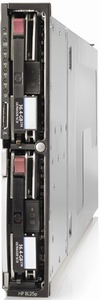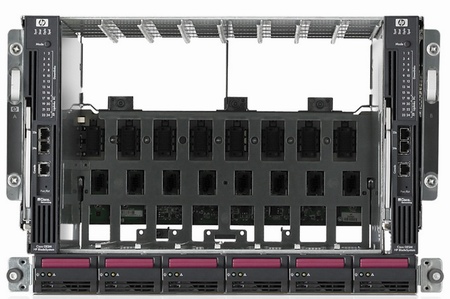Server Guide Part 1: Introduction to the Server World
by Johan De Gelas on August 17, 2006 1:45 PM EST- Posted in
- IT Computing
Blade servers: server nirvana?
The idea behind blade servers is brilliant. Imagine that you need about twelve 1U servers and you need them to be very reliable, attached to the KVM, networked and managed out of band. The result is that you have 24 power supplies, 12 KVM cables, at least 24 Ethernet cables (1 management, one network) and we are not even counting the number of cables to external storage or other devices.
What if you could put all of these 12 servers in one 6-7U chassis that has 3 (2+1) or 4 (2+2) very big power supplies instead of 24 small ones, and let them use a shared network switch, KVM switch and management module? That is exactly what a blade server is: a 6U, 7U or sometimes 10U chassis that can hold about 8 to 14 hot-swappable, vertically placed "mini-servers" called blades.
A server blade is a complete server with one or two processors and associated memory, disk storage and network controllers. Each blade within a system chassis slides into a blade bay, much like hot swappable hard disks in a storage rack. By sliding a blade into the bay, you also connect it to a shared backplane which is the link to the power supply, DVD-ROM, Ethernet and/or Fibre Channel switches, KVM switch and so on.
It doesn't take a genius to see that a blade server chassis with blades can be a more interesting option than a lot of 1U servers. The blade server should be easier to manage, offer more processing power in less space, and cost less as many components can be shared instead of being replicated in each 1U servers. Who needs 12 DVD players, 12 different remote management modules, and 24 power supplies?
According to the four biggest players in the server world - namely Intel, IBM, HP and Dell - blade servers are the way to the new enlightenment, to Server Nirvana. And there is no doubt about it, blade servers are hot: blade server sales have increased quite spectacularly, by 40% and more last year. They are certainly a very promising part of the server market... for some server applications.
The big four see the following advantages:
At the end of 2003, one year after the introduction of the blade server, IDC predicted that "the market share for blade servers will grow to 27% of all server units shipped in 2007" [2]. Currently IDC estimates are that blades account for 5 to 7% of the server market (unit shipments), so you probably can't help but wonder how IDC ever arrived at 27% in 2007. But that doesn't stop IDC from predicting again: by 2010, 25% of the server market will be conquered by blade servers. The truth is that blade servers are not always the best solution and have quite a long way to go before they can completely replace rack servers.
The idea behind blade servers is brilliant. Imagine that you need about twelve 1U servers and you need them to be very reliable, attached to the KVM, networked and managed out of band. The result is that you have 24 power supplies, 12 KVM cables, at least 24 Ethernet cables (1 management, one network) and we are not even counting the number of cables to external storage or other devices.
What if you could put all of these 12 servers in one 6-7U chassis that has 3 (2+1) or 4 (2+2) very big power supplies instead of 24 small ones, and let them use a shared network switch, KVM switch and management module? That is exactly what a blade server is: a 6U, 7U or sometimes 10U chassis that can hold about 8 to 14 hot-swappable, vertically placed "mini-servers" called blades.
A server blade is a complete server with one or two processors and associated memory, disk storage and network controllers. Each blade within a system chassis slides into a blade bay, much like hot swappable hard disks in a storage rack. By sliding a blade into the bay, you also connect it to a shared backplane which is the link to the power supply, DVD-ROM, Ethernet and/or Fibre Channel switches, KVM switch and so on.
 |  |
| Individual Blade and a Blade Chassis | |
It doesn't take a genius to see that a blade server chassis with blades can be a more interesting option than a lot of 1U servers. The blade server should be easier to manage, offer more processing power in less space, and cost less as many components can be shared instead of being replicated in each 1U servers. Who needs 12 DVD players, 12 different remote management modules, and 24 power supplies?
According to the four biggest players in the server world - namely Intel, IBM, HP and Dell - blade servers are the way to the new enlightenment, to Server Nirvana. And there is no doubt about it, blade servers are hot: blade server sales have increased quite spectacularly, by 40% and more last year. They are certainly a very promising part of the server market... for some server applications.
The big four see the following advantages:
- Reductions in cable complexity
- Operational cost savings
- Data center space savings
- Lower acquisition costs
- Improved high availability
- More efficient power usage
At the end of 2003, one year after the introduction of the blade server, IDC predicted that "the market share for blade servers will grow to 27% of all server units shipped in 2007" [2]. Currently IDC estimates are that blades account for 5 to 7% of the server market (unit shipments), so you probably can't help but wonder how IDC ever arrived at 27% in 2007. But that doesn't stop IDC from predicting again: by 2010, 25% of the server market will be conquered by blade servers. The truth is that blade servers are not always the best solution and have quite a long way to go before they can completely replace rack servers.










32 Comments
View All Comments
JarredWalton - Thursday, August 17, 2006 - link
Fixed.Whohangs - Thursday, August 17, 2006 - link
Great stuff, definitely looking forward to more in depth articles in this arena!saiku - Thursday, August 17, 2006 - link
This article kind of reminds me THG's recent series of articles on how computer graphics cards work.For us techies who don't get to peep into our server rooms much, this is a great intro. Especially for guys like me who work in small companies where all we have are some dusty Windows 2000 servers stuck in a small server "room".
Thanks for this cool info.
JohanAnandtech - Friday, August 18, 2006 - link
Thanks! Been in the same situation as you. Then I got a very small budget for upgrading our serverroom (about $20000) at the university I work for and I found out that there is quite a bit of information about servers but all fragmented, and mostly coming from non-independent sources.splines - Thursday, August 17, 2006 - link
Excellent work pointing out the benefits and drawbacks of Blades. They are mighty cool, but not this second coming of the server christ that IBM et al would have you believe.Good work all round. It looks to be a great primer for those new to the administration side of the business.
WackyDan - Thursday, August 17, 2006 - link
Having worked with blades quite a bit, I can tell you that they are quite a significant innovation.I'll disagree with the author of the article that there is no standard. Intel co-designed the IBM bladecenter and licensed it's manufacture to other OEMS. Together, IBM and Intel have/had over 50% share inthe blade space. THat share along with Intel's collaboration is by default considered the standard int he industry.
Blades, done properly, have huge advantages over their rack counterparts. ie; far less cables. In the IBM's the mid-plane replaces all the individual network and optical cables as the networking modules (copper and fibre) are internal and you can get several flavors... Plus I only need one cable drop to manage 14 servers....
And if you've never seen 14 blades in 7u of space fully redundant, your are missing out. As for VMware, I've seen it running on blades with the same advantages as it's rack mount peers... and FYI... Blades are still considered rack mount as well...No you are not going to have any 16/32 ways as of yet.... but still, Blades really could replace 80%+ of all traditional rack mount servers.
splines - Friday, August 18, 2006 - link
I don't disagree with you on any one point there. Our business is in the process of moving to multiple blade clusters and attached SANs for our excessively large fileservers.But I do think that virtualisation does provide a great stepping-stone for business not quite ready to clear out the racks and invest in a fairly expensive replacement. We can afford to make this change, but many cannot. Even though the likes of IBM are pushing for blades left right and centre I wouldn't discount the old racks quite yet.
And no, I've haven't had the opportunity to see such a 7U blade setup. Sounds like fun :)
yyrkoon - Friday, August 18, 2006 - link
Wouldnt you push a single system that can run into the tens of thousands, to possibly hundreds of thousands for a single blade ? I know i would ;)Mysoggy - Thursday, August 17, 2006 - link
I am pretty amazed that they did not mention the cost of power in the TCO section.The cost of powering a server in a datacenter can be even greater than the TCA over it's lifetime.
I love the people that say...oh a got a great deal on this dell server...it was $400 off of the list price. Then they eat through the savings in a few months with shoddy PSUs and hardware that consume more power.
JarredWalton - Thursday, August 17, 2006 - link
Page 3:"Facility management: the space it takes in your datacenter and the electricity it consumes"
Don't overhype power, though. There is no way even a $5,000 server is going to use more in power costs over its expected life. Let's just say that's 5 years for kicks. From http://www.anandtech.com/IT/showdoc.aspx?i=2772&am...">this page, the Dell Irwindale 3.6 GHz with 8GB of RAM maxed out at 374W. Let's say $0.10 per kWHr for electricity as a start:
24 * 374 = 8976 WHr/Day
8976 * 365.25 = 3278484 WHr/Year
3278484 * 5 = 16392420 WHr over 5 years
16392420 / 1000 = 16392.42 kWHr total
Cost for electricity (at full load, 24/7, for 5 years): $1639.24
Even if you double that (which is unreasonable in my experience, but maybe there are places that charge $0.20 per kWHr), you're still only at $3278.48. I'd actually guess that a lot of businesses pay less for energy, due to corporate discounts - can't say for sure, though.
Put another way, you need a $5000 server that uses 1140 Watts in order to potentially use $5000 of electricity in 5 years. (Or you need to pay $0.30 per kWHr.) There are servers that can use that much power, but they are far more likely to cost $100,000 or more than to cost anywhere near $5000. And of course, power demands with Woodcrest and other chips are lower than that Irwindale setup by a pretty significant amount. :)
Now if you're talking about a $400 discount to get an old Irwindale over a new Woodcrest or something, then the power costs can easily eat up thost savings. That's a bit different, though.